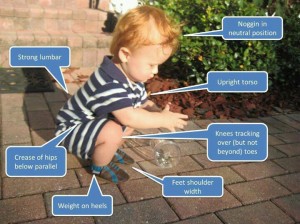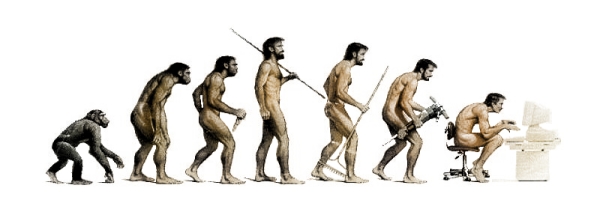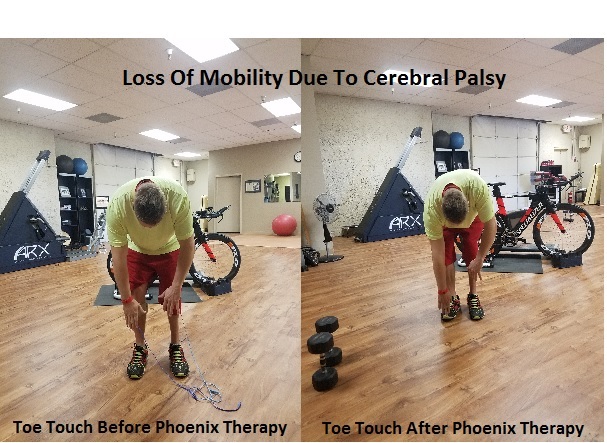Preventing and resolving pain
Most pain and injury can be found in imbalances with in the joints and muscles which then result in the body compensating structurally. By getting at the structural root, we will eliminate compensatory patterns that bring about pain and injury.
Maximizing athletic performance
The more muscle we have integrated into a movement, the more energy we can deliver. Whether you’re looking to improve a 100 yard dash, punch harder, improve triathlon times, proper movement will be at the foundation of what you will need to improve your performance.
After 20 min of specific functional movements assisted by deep AC/DC muscle stimulation, Jason (who has cerebral palsy) touches his toes for the first time.
The follow article written by Dr. Jeff Banas is from SuperHumanCoach.com
The internet is filled with sport specific functional training tools claiming make you jump higher, swim faster and run farther. Many coaches and training plans also make claims that they can enhance your athletic performance by following their specific method of coaching.
But, do any of these gadgets really work?
Will doing plyometric box jumps make you a better runner, or will they just make you better at doing plyometric box jumps?
Will increasing the distance you can throw a twenty pound medicine ball make you swim faster, or just make you better a throwing medicine balls?
The problem is, just because you got stronger in a particular exercise does not mean that it transforms into improvement in a particular sport or activity.
You may actually look and exercise better, but you may not perform any better. You may be superhuman in the weight room, but a bust on race day. Here’s how…
I am sure many of you have experienced this, endless hours of training and drills with little or no improvements in your race results. Or even worse, you were not able to compete in your sport or activity because you were injured.
So what’s the problem? Is there something wrong with all of these training tools and programs?
Actually many of the training gadgets can be very useful. The problem is, in our pursuit of athletic enhancement we often forget that form and movement depicts our function. Our movement patterns are the foundation of all the other skills, exercises, and activities that we do.
Improving strength is the foundation of most athletic activities, but only if it is stacked on top of good movement patterns.
If you lack good basic movement patterns, you have no business pursuing sport specific training.
Why? Because if your basic movement patterns are flawed, the foundation of your specific skill will be flawed. In other words, if you can not perform a simple squat or touch the floor without pain, stiffness or compensation, something that virtually every normal two year old child can do, how can you really expect to improve your performance?
Do you injure often or suffer from chronic or re-occurring injuries? Again, if you can not do a simple lunge or reach behind you head without pain, stiffness or compensation no wonder you are getting injured all the time.
As babies, we were limber and symmetrical. We crawled and rolled around on the floor and we squatted when we needed to pick something up. But over time, we stopped playing on the floor, we stopped squatting and we began bending at the waist to pick things up. We started living in a box. Driving in our box and sitting in a box all day at work. Over time, we developed muscle imbalances and asymmetries, which can make us less efficient and more prone to injury.
something up. But over time, we stopped playing on the floor, we stopped squatting and we began bending at the waist to pick things up. We started living in a box. Driving in our box and sitting in a box all day at work. Over time, we developed muscle imbalances and asymmetries, which can make us less efficient and more prone to injury.
So how can you access your movement patterns and find out where you weak links might be?
Ideally you would want to have a Movement Screen by a trained sports therapist. At my office we do what is called a Functional Movement Screen, which was developed by Gray Cook, P.T.
The Functional Movement Screen is a series of basic movement patterns that are keys to normal function.
Although not as detailed or in depth, it is possible to do a self movement screen.
In this video, Gray Cook takes you through a self movement screen.
Be honest with yourself. Did you pass the tests, fail the tests, or did you have pain during any of the tests?
If you failed any of the movement patterns you need corrective exercise, no matter how strong or in shape you think you are. Remember, if your basic movement patterns are flawed, the foundation of your specific skill or activity will also be flawed. You need to spend more time stretching and moving in the movement pattern that you failed.
If you had pain during any of the movement patterns, that’s not normal. You have a medical problem that needs to be addressed. You can not just avoid movements that cause you pain. The cause of your pain needs to be addressed and then you need to step up your training and focus on improving your movement patterns. If you simply train around your pain, or don’t work on improving your faulty movement patterns, you will never reach your true athletic potential. So, if you had any pain during any of the tests find a good sports therapist and get an evaluation.
If you failed any of the tests, stretch and do exercises that are similar to the movement patterns that you had problems with. Then in a few weeks, re-test and see if your movement patterns have improved. If your movement patterns improved, you fixed it, if your movement patterns didn’t improve, get some help from a good sports therapist who is trained in movements screens.

